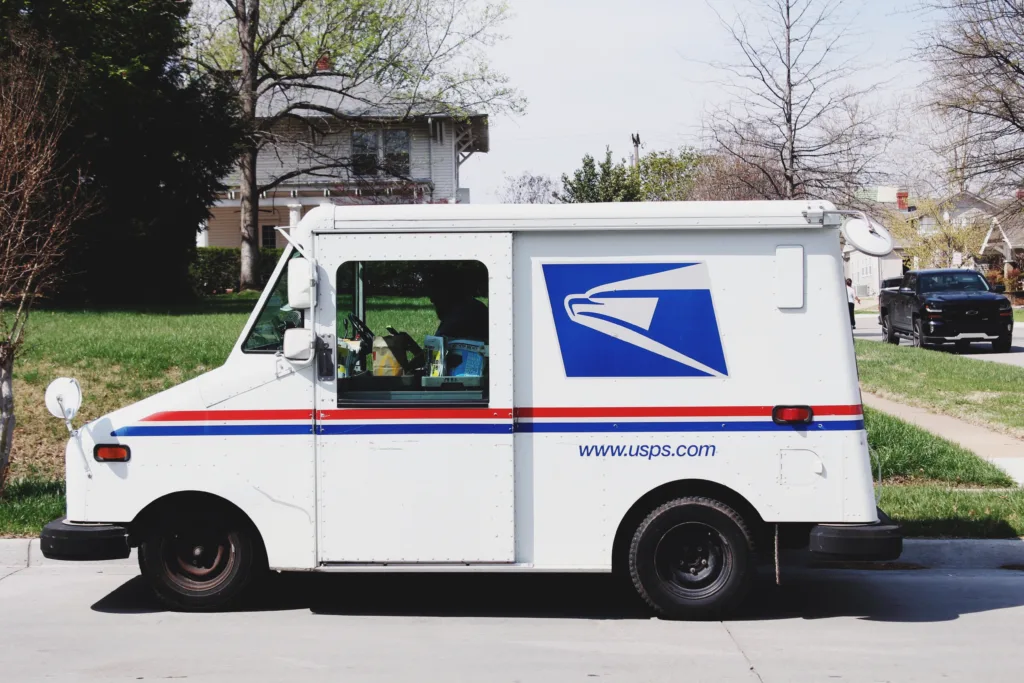Postmarked mail is a crucial aspect of the United States Postal Service (USPS) system that provides important information about the origin, date, and location of a piece of mail. In this article, we will explore the significance of postmarks, how to obtain them, and their role in ensuring the timely delivery of mail.
A postmark is an imprint made by a USPS office on letters, flats, and parcels to indicate the office’s name, state, zip code, and the date of mailing. It serves as proof that the USPS has accepted custody of the mail and is responsible for its delivery. Postmarks are particularly important for legal and official documents, as they provide evidence of when the mail was sent, received, or processed.
To obtain a postmark, one can simply visit their local post office and request it. The postal worker will stamp the mail with the postmark, providing peace of mind and assurance that the mail has been officially received by the USPS. This is especially useful when sending time-sensitive or important documents, as the postmark serves as a timestamp for legal purposes.
When preparing a piece of mail for sending, there are a few key elements to consider. Firstly, a stamp should be affixed to the top right-hand corner of the envelope. The stamp ensures that the sender has paid for the postage required to send the mail. Without a stamp, the mail may not be processed or delivered.
Next, the destination address should be clearly written in the center of the envelope. This address indicates where the mail is intended to be delivered. It is essential to provide accurate and complete information to ensure proper delivery.
Lastly, the return address should be included on the envelope. This is the sender’s address and serves as a means for the USPS to return the mail in case it is undeliverable. Including a return address is particularly important when mailing important documents or items that require a higher level of security.
It is important to note that not all mail receives a postmark. The USPS only postmarks certain types of mail, depending on the type of postage used. Additionally, postmarks may not always be applied on the same day the mail is delivered to the post office. Therefore, it is advisable to allow for sufficient time when sending time-sensitive materials.
In cases where a payment is involved, it is crucial to ensure that the mail is postmarked by the USPS. If a payment is received without a USPS postmark, it is considered received on the date it physically arrives at the intended destination.
Postmarked mail plays a significant role in the USPS system by providing essential information about the origin, date, and location of a piece of mail. Obtaining a postmark is a simple process that can be done at the local post office. By following the proper procedures for stamp placement, addressing, and including a return address, senders can ensure the timely and secure delivery of their mail.
What Is Considered Postmarked Mail?
Postmarked mail refers to letters, flats, or parcels that have been officially stamped by a United States Postal Service (USPS) office to indicate the date and location of mailing. The postmark imprint serves as proof that the USPS has accepted custody of the mail and has initiated the process of delivery.
Here are some key points to understand about postmarked mail:
1. Purpose: The primary purpose of a postmark is to provide evidence of when an item was mailed. It ensures that the sender meets certain deadlines, such as filing tax returns or submitting time-sensitive documents.
2. USPS Office Name: The postmark includes the name of the USPS office that accepted custody of the mail. This helps identify the specific location where the item was mailed from.
3. State and Zip Code: The postmark also includes the state and zip code of the USPS office. This information provides additional details about the origin of the mail.
4. Date of Mailing: The postmark prominently displays the date on which the mail was processed by the USPS. This date is crucial for determining compliance with various deadlines and time-sensitive requirements.
5. Imprint Location: The postmark is typically imprinted on the envelope, flat, or parcel in a designated area, often near the postage stamp. It is applied using a special machine or manually by a USPS employee.
6. Legibility: Postmarks should be clear and legible to ensure accurate recording of the mailing date. However, sometimes postmarks may become smudged or difficult to read due to various factors, such as ink quality or handling during transit.
7. Importance: The presence of a postmark can be crucial in legal and official matters, as it provides an official record of when the mail was sent. It can serve as proof of timely submission, particularly for items requiring specific postmark dates.
8. Postage Validation: Postmarks also serve as a validation that the appropriate postage has been affixed to the mail. This helps prevent underpayment and ensures that the mail is processed correctly.
Postmarked mail refers to items that have been officially stamped by a USPS office, indicating the date, location, and acceptance of the mail. The postmark is essential for documenting the mailing process, meeting deadlines, and serving as proof of timely submission.

How Do I Receive Postmarked Mail?
To receive mail with a postmark, you can follow these steps:
1. Locate your nearest post office: Use the official website of your country’s postal service or a reliable online directory to find the nearest post office branch to your location.
2. Prepare your mail: Make sure your mail is properly addressed and ready to be sent. Ensure that it meets all the necessary requirements for mailing, such as proper packaging and correct postage.
3. Visit the post office: Take your prepared mail to the post office during their operating hours. It’s advisable to choose a time when the post office is less crowded to minimize waiting time.
4. Approach the counter: Once you’re at the post office, find the counter designated for customer service or mail-related inquiries. If unsure, don’t hesitate to ask any staff member for assistance.
5. Request a postmark: Politely explain to the postal clerk that you would like to have your mail postmarked. They will provide you with a stamp specifically designed for this purpose.
6. Present your mail: Hand over your mail to the postal clerk, who will then apply the postmark stamp to your envelope or package. They may also ask you to confirm the date of mailing.
7. Confirm and pay: If there are any fees associated with obtaining a postmark, the postal clerk will inform you and guide you through the payment process. Be prepared to pay using the accepted payment methods at the post office.
8. Collect your postmarked mail: Once the postmark has been applied, the postal clerk will return your mail to you. Double-check that everything is in order before leaving the counter.
9. Keep the receipt: If the post office provides a receipt or any documentation related to the postmark, make sure to keep it in a safe place for future reference.
10. Track your mail (optional): If you want to track the progress of your mail, many postal services offer tracking services. You can inquire about this option at the post office or check their website for more information.
Remember, the process may vary slightly depending on your location and the specific procedures followed by your local post office. It’s always beneficial to familiarize yourself with any additional guidelines provided by your postal service to ensure a smooth experience.
How Do You Send A Postmarked Mail?
To send a postmarked mail, follow these step-by-step instructions:
1. Prepare your letter or package: Write your message on a piece of paper or print it out. If you’re sending a package, make sure it is securely wrapped and sealed.
2. Place the letter or package in an envelope: Fold your letter neatly and place it inside an envelope. If you’re sending a package, use an appropriate-sized box or padded envelope.
3. Affix a stamp: In the top right-hand corner of the envelope, attach a postage stamp. The stamp should correspond to the weight and size of your mail. If you’re unsure about the required postage, you can check with your local post office or use an online postage calculator.
4. Write the destination address: In the center of the envelope, write the complete address of the person or organization you’re sending the mail to. Include their name, street address, city, state, and zip code. It’s important to write the address legibly and accurately to ensure proper delivery.
5. Add a return address: On the top left-hand corner of the envelope, write your complete return address. This includes your name, street address, city, state, and zip code. Having a return address allows the postal service to return the mail to you in case it cannot be delivered.
6. Postmarking the mail: Once you have prepared the envelope with the stamp, destination address, and return address, take it to your local post office or mailbox. The postal service will then apply a postmark to your mail, indicating the date and location of mailing. This postmark serves as proof of sending and helps track the progress of your mail.
7. Obtain proof of mailing if necessary: If you require proof that you sent the mail, such as for legal or business purposes, you can request a receipt or a Certificate of Mailing from the post office. This document will provide confirmation that your mail was officially sent.
Remember to check any specific mailing requirements or restrictions that may apply to your particular situation or destination. It’s also advisable to check with your local postal service for any additional guidelines or regulations.
Is Regular Mail Postmarked?
Regular mail may or may not be postmarked by the USPS. The postmark indicates the date and location of when the mail item was processed by the postal service. However, not all types of postage require a postmark. For example, some types of pre-printed or metered postage may not receive a postmark.
It’s important to note that even if regular mail is postmarked, it doesn’t necessarily mean that it was postmarked on the same day it was delivered to the USPS. Postmarking can occur at different stages of the mail processing, which may result in a delay between the actual delivery and the date on the postmark.
In cases where a payment is received without a USPS postmark, the date of receipt is typically considered to be the date when it physically arrives in the recipient’s office. This means that even if there is no postmark, the payment will be treated as received on the date it is physically received.

Conclusion
Postmarked mail refers to letters, flats, and parcels that bear an imprint from the United States Postal Service (USPS) office where they were accepted. This imprint includes the name of the USPS office, the state, the zip code, and the date of mailing. Postmarks are important because they provide evidence of when the mail was accepted and can be used to verify the timeliness of its delivery. To obtain a postmark, individuals can visit their local post office and request it at the time of mailing. It is crucial to note that not all mail items are postmarked, as it depends on the type of postage used. Additionally, the USPS may not postmark mail on the same day it is delivered, so it is advisable to allow sufficient time for the postmark to be applied. When sending mail, it is essential to affix a stamp in the top right-hand corner of the envelope and properly address both the destination and return addresses. By following these guidelines, senders can ensure their mail receives a postmark and is processed in a timely manner by the USPS.
